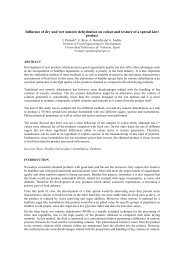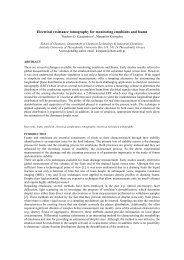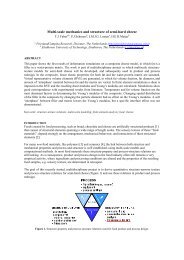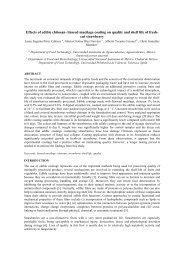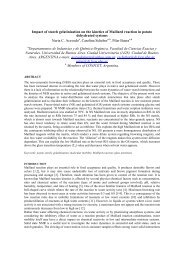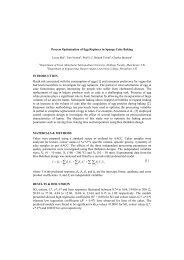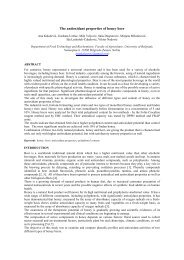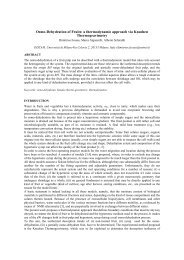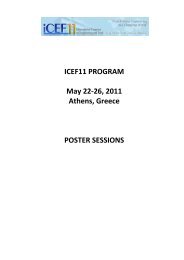Kinetics of Amycolatopsis mediterranei DSM 43304 lipase-mediated ...
Kinetics of Amycolatopsis mediterranei DSM 43304 lipase-mediated ...
Kinetics of Amycolatopsis mediterranei DSM 43304 lipase-mediated ...
You also want an ePaper? Increase the reach of your titles
YUMPU automatically turns print PDFs into web optimized ePapers that Google loves.
for the kinetic model building [10,11]. The description <strong>of</strong> this mechanism and the associated rate (r) is given<br />
by Eq. (1) [35].<br />
⎪⎧<br />
[ ] [ ]<br />
[ ΙΑΑc] × [ Η ] ⎪⎫<br />
2Ο<br />
ν<br />
fν<br />
r ⎨ Αc<br />
× Η<br />
2Ο<br />
−<br />
⎬<br />
⎪⎩<br />
keq<br />
r =<br />
⎪⎭<br />
(1)<br />
⎛<br />
{ [ ] [ ]<br />
[ ΙΑΑ]<br />
⎞ ν<br />
f<br />
km,<br />
Η Ο<br />
ν<br />
f<br />
k<br />
2<br />
m,<br />
ΙΑΑc<br />
ν<br />
⎜<br />
⎟<br />
f<br />
km,<br />
ΙΑΑ<br />
Αc<br />
+ ν<br />
rkm,<br />
Αc<br />
ΙΑΑ × 1 + + [ ΙΑΑc] + [ Η<br />
2Ο] + ν<br />
f<br />
[ Αc] × [ Η2Ο]<br />
⎝ k'<br />
ΙΑΑ ⎠ keq<br />
keq<br />
ν<br />
f<br />
km,<br />
Η Ο<br />
ν<br />
f<br />
ν<br />
rk<br />
2<br />
m,<br />
Αc<br />
+ [ Αc] × [ ΙΑΑc] + [ ΙΑΑc] × [ Η2Ο] + [ ΙΑΑ] × [ Η<br />
2Ο] }<br />
k k<br />
k<br />
k<br />
eq i,<br />
Αc<br />
eq<br />
i,<br />
Η 2Ο<br />
where v f and v r are the maximal velocities for the forward and the reverse reactions, respectively, k eq is the<br />
equilibrium constant, k m,IAA , k m,Ac , k m,H2O and k m,IAAc are the Michaelis-Menten constants for isoamyl alcohol<br />
(IAA), acetic acid (Ac), water (H 2 O) and isoamyl acetate (IAAc), respectively, k’ IAA is the inhibition constant<br />
for IAA, and k i,Ac and k i,H2O are the dissociation constants for Ac and H 2 O from the specific enzyme-inhibitor<br />
complex, respectively.<br />
Owing to the mathematical complexity <strong>of</strong> this full-model involving ten adjustable parameters with associated<br />
problems <strong>of</strong> unidentifiability and indistinguishability <strong>of</strong> different parameters under normal experimental<br />
situations, a strategy to study the effect <strong>of</strong> dropping out some parameter(s) in order to produce a simpler<br />
model was implemented [11, 34]. Following the methodology <strong>of</strong> Paiva et al. [11], the Michaelis-Menten<br />
dissociation constant terms for each <strong>of</strong> the compounds (k m,x , where ‘x’ represents either [Ac], [IAA], [IAAc]<br />
or [H 2 O]) from the enzyme complex were considered for model reduction; the elimination <strong>of</strong> these<br />
parameters from the denominator <strong>of</strong> model rate constant would mean that such parameters assume high<br />
values in respect to the experimental data and there is no evidence <strong>of</strong> saturation in the concentration range<br />
studied or there is no affinity <strong>of</strong> the enzyme to the compound in question. In order to study the adequacy <strong>of</strong><br />
this hypothesis, the model from Segel [35] was reformulated by eliminating the dissociation constants<br />
yielding simpler models. These models were separately fitted to the experimental data and F-tests were<br />
performed on the associated residual sum <strong>of</strong> squares with the aim <strong>of</strong> investigating the statistical likelihood <strong>of</strong><br />
such simplifications. The results obtained in this comparison are presented in Table 1.<br />
Table 1. F-test results for model nesting<br />
Source model SSQ parameters<br />
Model<br />
(NP)<br />
df RSS a df<br />
Extra<br />
(σ) b<br />
Mean<br />
square<br />
(s 2 ) c F<br />
ratio d<br />
P<br />
value<br />
Full model vs. Nested-1<br />
Eq- 1 793.49 10 53 – – 14.97 – –<br />
Eq-2 792.97 4 59 -0.52 6 -0.09 -0.01 0.99<br />
a Residual sum <strong>of</strong> squares is the difference in the SSQ <strong>of</strong> models, b Extra degrees <strong>of</strong> freedom is the difference in the<br />
number <strong>of</strong> model parameters. c Mean square is the residual sum <strong>of</strong> squares divided by degrees <strong>of</strong> freedom (df). d F ratio is<br />
the full model (f) mean square divided by the mean square <strong>of</strong> the nested model (n),<br />
It can be concluded that, at p < 0.05 level <strong>of</strong> statistical significance, the resulting rate expression can be<br />
described by Eq. (2).<br />
⎪⎧<br />
[ ΙΑΑc] × [ Η ] ⎪⎫<br />
2Ο<br />
{( k<br />
cat f<br />
[ Et<br />
]) × ( k<br />
cat r<br />
[ Et<br />
])} × ⎨[ Αc] × [ ΙΑΑ]<br />
−<br />
⎬<br />
⎪⎩<br />
k<br />
eq ⎪⎭<br />
r =<br />
(2)<br />
( k<br />
f<br />
[ Et<br />
])<br />
( k [ ])[ Αc] × [ ΙΑΑ] cat<br />
cat r<br />
Et<br />
+ [ ΙΑΑc] × [ Η<br />
2Ο]<br />
k<br />
The experimental concentration pr<strong>of</strong>iles were modeled using Eq. (2). Experimental points and the simulated<br />
curves obtained with the developed model are shown in Figure 1. The simulated curves follow reasonably<br />
well the experimental points, showing the kinetic model using Eq. (2) is able to describe the entire reaction<br />
progress under conditions <strong>of</strong> equimolar initial substrate concentrations as well as excess <strong>of</strong> one <strong>of</strong> the<br />
substrates (see Figure 1 for prediction and Table 2 for estimated parameters).<br />
eq



